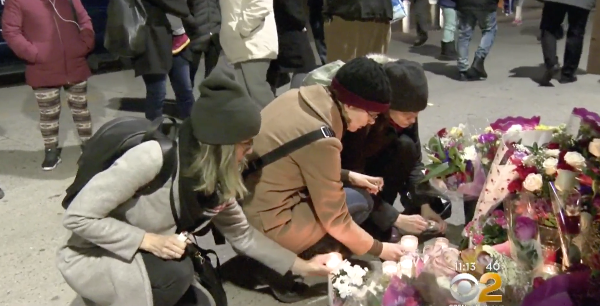New York Times columnist Ginia Bellafante has a column today taking aim at our legal system and culture of complicity that “treats cars much in the way it treats guns, sanctioning the right to operate them as nearly sacrosanct” and thus enabled Staten Island resident Dorothy Bruns on Monday to plow through a Park Slope crosswalk and kill 4-year-old Abigail Blumenstein and 1-year-old Joshua Lew.
Bellafante’s broadside against traffic violence is a welcome change from the saccharine stance of Times columnists like Nicholas Kristof, who habitually valorizes U.S. driver licensure as a model for reducing gun violence. As if licensing regimes were making the slightest dent in the seemingly bottomless pool of unfit drivers whose “right” to get behind the wheel may never be abridged.
In her column today, Bellafante links to an earlier piece on traffic violence, Is It Safe to Cross?, which ran five years ago today. That column addressed the vehicular killing of writer and mother Martha Atwater, who lost her life when John McKinney drove his SUV onto a downtown Brooklyn sidewalk and pinned her against a building wall. At the time, both the NY Post and Bellafante unwittingly let the NYPD use them to exculpate McKinney:
The Post: “The 53-year-old driver may have lost consciousness because of diabetes, a police source said.”
Big City (The Times): “According to the Police Department, the driver, John McKinney, lost control when he experienced a blackout related to diabetes.”
In fact, as Bellafante points out today, “diabetes” was less a medical diagnosis than a dodge covering up McKinney’s drug dependence:
Mr. Wallack [Atwater’s husband] learned that the driver had been arrested twice for heroin possession during the 18 months preceding the crash. . . He was still permitted to keep his car, the car he was driving when Martha Atwater was killed. Mr. Wallack also discovered that the driver had his license suspended in the past.
The link to the loss of two young children on Ninth Street is two-fold: Bruns’ car had been issued eight violations for speeding in school zones and blowing red lights in less than two years, as the Post reported on Tuesday, even as the NYPD insisted it had “no record of Bruns having any traffic violations”; and NYPD are falling over themselves to let MS, stents and seizures take the rap for Bruns’ driving through a steady red and into the Park Slope crosswalk on Monday, killing the two children and seriously injuring their mothers.
An analysis this week by Brooklyn-based engineer and safe-streets advocate Will Farr revealed that Bruns’ car is just one of a quarter of a million vehicles that racked up three or more speeding violations in school zones in the past few years — potentially enough to trigger license suspensions. By mining NYC’s Open Data Portal, Farr was able to construct the plot below highlighting repeat offending recorded by the city’s 140 speed cams.
Since speeding “11 mph over” translates to four license points, three instances within 18 months would have exceeded the 11 points needed to trigger a suspension, if violations tied to a vehicle could be attributed to the owner.
The clunker in Bellafante’s column, however, is her assertion that ticket automation like speeding or red-light cams “has a real cost [because] it removes the presence of a police officer who could pull a speeding driver over and see if something might be off.”
Her concern points 180 degrees away from the emerging consensus among traffic safety advocates that the police are not up to the task of addressing dangerous driving. Here’s City Journal and Post columnist Nicole Gelinas this week calling for more, not less automated enforcement:
Police officers are expensive; cameras are not. Moreover, cameras don’t discriminate — a camera won’t let a driver with, say, a public-sector union sticker get away with bad behavior while stopping an out-of-state driver. Nor can cameras be accused of disparate treatment on the basis of race.
Others go further. After the Park Slope carnage, Streetsblog founding editor Aaron Naparstek tweeted that it’s time to “Remove human NYPD cops from the job of traffic enforcement. They are very bad at it, they don't like doing it, and it's really not a good use of human police resources.” And activist Keegan Stephan wrote in a 2016 manifesto that “It is long past time for everyone to admit that the NYPD is incompatible with safe streets. They cannot be reformed in any meaningful way. Wherever possible, their enforcement should be eliminated.”
In another tweet on Monday, Naparstek called for transforming Vision Zero into “a system that: 1. Identifies habitually reckless drivers before they do harm. 2. Communicates with them to improve their driving. 3. Removes them from the transportation network if necessary.”
“Vision Zero should have caught this driver [Bruns] before she killed,” he concluded. To reboot Vision Zero, Naparstek would deploy new metrics identifying and tracking reckless driving, interventions to remediate and if necessary bar habitually dangerous drivers, and price roads and parking while increasing car-sharing to radically reduce traffic volumes.
Next to that agenda, calming one dangerous street at a time, as NYC DOT promised this week, too late, for Ninth Street, seems just part of the task before us. The pace of street redesigns must be accelerated, but also our legal, political, and cultural framework that hands out licenses willy-nilly and pretty much lets anyone drive anywhere, anyhow, anytime needs overhauling.
The lifers who populate DMV, NYPD, and, yes, NYC DOT have turned aside repeated entreaties to brainstorm a remake. In street safety, as in transit reform, cycling, road pricing, and every other avenue to livable streets, it’s going to fall on advocates to find the way.







